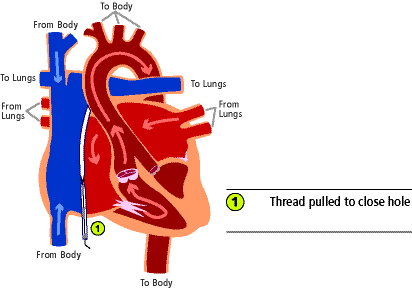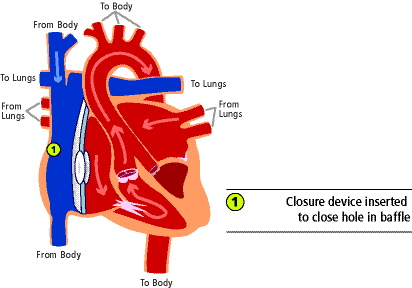Hypoplastic Left Heart Syndrome Fenestration Closure via Heart Catheterization is necessary is when a large fenestration or hole in the Fontan baffle is closed. It is done during a heart catheterization six to twelve months after the Fontan procedure. Most children require only a small fenestration that closes with time.
Why is the fenestration made?
The hole allows the lungs to gradually get used to getting all the blue blood directly from the body. It allows some of the blue blood to bypass the lungs if the pressure gets too high. Once the lungs having gotten used to the new system, the hole can be closed or closes on its own. After the hole closes, all the blue blood goes to the lungs and the child's lips and fingernails look pink.
How is the fenestration closed?
If the hole does not close on its own, it is closed during a heart catheterization while the child is under general anesthesia. During the procedure catheters (thin plastic tubes) are placed into the large blood vessels in the legs and "floated" into the heart.
Different methods can be used to close the hole. In one method, a suture is loosely sewn around the hole during the Fontan procedure. The sutures are protected by a thin plastic tube (1) and tunneled to the abdomen. When the child is asleep, a small cut is made below the breastbone. This allows the doctor to reach the plastic tube and the ends of the thread that go around the hole. The ends of thread are gently pulled, closing the hole. The wound is then sewn up and covered with a bandage.

Another method (below) of closing the hole is using a closure device (1). In this method, the device is delivered to the site of the fenestration collapsed within a catheter. After the catheter tip is moved into place, the device is pushed out of the catheter, across the atrial septal defect, and secured in place. The child usually stays in the hospital for one night after this procedure.

